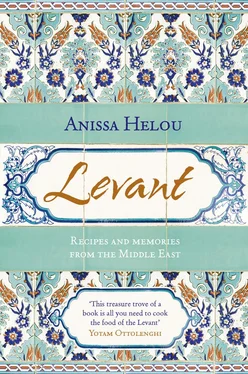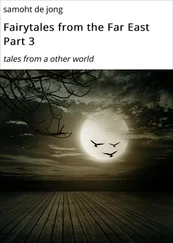
For my mother and late father , who taught me to love food.
Also for my late grandmother and Aunt Zahiyeh.
And for my siblings who were the first to share with me all those delicious dishes we grew up with.
Contents
Cover
Title Page
Dedication For my mother and late father , who taught me to love food. Also for my late grandmother and Aunt Zahiyeh. And for my siblings who were the first to share with me all those delicious dishes we grew up with.
Levant
En Famille
On the Farm
In the Souk
At the Restaurant
At the Bakery
At the Sweet-maker’s
Glossary
Select Bibliography
List of Searchable Terms
Acknowledgements
Also by Anissa Helou
List of Recipes
Copyright
About the Publisher
Contents Cover Title Page Dedication For my mother and late father , who taught me to love food. Also for my late grandmother and Aunt Zahiyeh. And for my siblings who were the first to share with me all those delicious dishes we grew up with. Levant En Famille On the Farm In the Souk At the Restaurant At the Bakery At the Sweet-maker’s Glossary Select Bibliography List of Searchable Terms Acknowledgements Also by Anissa Helou List of Recipes Copyright About the Publisher
S oleil levant means ‘rising sun’ in French and ‘Levant’ – the land to the east, where the sun rises – is the word that came to describe the eastern Mediterranean at a time when the Mediterranean, which links three continents, Europe, Asia and Africa, was the centre of the world.
The term became current in the late sixteenth century with the creation of the English Levant Company that traded with the Ottoman Empire. A century later, the French set up the Companie du Levant for the same purpose and during the eighteenth and nineteenth centuries ‘Levant’ became widely used by travellers in their accounts of the region, although not always referring to the same countries.
My Levant encompasses my own home countries, Lebanon and Syria, which were called the Levant States by the French when they had a mandate over them from 1920 to 1946 – as a child, I spent the school year in Lebanon, in Beirut, and my summers in Mashta el-Helou in Syria. The term Levant for me also includes Turkey, Jordan, Palestine and northern Iran. Inclusion of the latter may be controversial, but Iranian cooking is the mother cuisine of the region. The Abbassid caliphs, who ruled from the eighth to the thirteenth centuries, favoured Persian cooks, and as their empire expanded, they took them along, which explains the sweeping influence of Persian cuisine over the cooking of the Middle East and North Africa. This, I think, gives me licence to include some of Iran’s classic northern dishes. The non-inclusion of Israel may be construed as controversial too, but as everyone knows, Israel is a very young state and many dishes that are now described as Israeli were originally, and still are, Palestinian, Lebanese or Egyptian, and I prefer to give the original rather than the assumed version of a dish where I can. Another country I could have included is Cyprus, which some historians and travel writers regard as part of the Levant. I have chosen not to include dishes from Cyprus in this book simply because this is a personal compilation of favourite recipes rather than a scholarly work, and as such I have made my own, very selective choice.
Most of the essential ingredients – be they grains, pulses, nuts and spices or seasonal produce – are common to the region as a whole. Many dishes are also shared between different countries, while just as many are specific to one country or another. Equally, when dishes are shared, there is enough of a difference in the way they are prepared to single them out as belonging to a particular country.

Anissa standing in front of one side of al-Dar in Mashta el-Helou, her father’s ancestral home in Syria.
Even the dominant flavours can be defined from one country to another. There are no combinations of sweet and savoury in Lebanon where the emphasis is on tart, fresh flavours. By contrast, complex or intriguing flavours are preferred in Turkey, northern Syria and Iran where dishes combine meat with fruit, and in some cases fruit juice, to create enticing sweet-savoury mixtures. Jordan and Palestine favour more subdued flavours and their dishes tend to be higher in fat, as do those from southern Syria. And Iran is the only region where rice is king, whereas burghul and frikeh (‘burnt’ green wheat that is dried and either cracked or left whole) are the staple elsewhere.
The main staple in the Levant is bread, an essential part of meals, but this too varies from one country to another. In Lebanon, a very thin, large pita is the most common type, used to scoop up food and to make wraps. Even though the country is tiny, there are regional variations, including marqûq , a very large, paper-thin mountain bread baked over a saj (a kind of inverted wok), and mishtah , a flatbread from the south that is flavoured with spices and has added cracked wheat ( jrish ). Both are single-layered whereas further north you will find tabuneh , which is double-layered like pita but larger and thinner. Neither mishtah nor tabuneh tend to be found outside their region; indeed, I never knew them when I lived in Lebanon, discovering them only a few years ago when I was researching my book on savoury baking.
In Syria, the common bread, at least in rural areas, is tannur , a large, round single-layered loaf that takes its name from the tannur that was the original pit oven, built either below or above ground. Pita is common in cities and small towns where there are commercial bakeries. A few bakeries make marqûq although the bread is not as common in Syria as it is in Lebanon. Jordan and Palestine have more or less the same type of bread, including shraak , which is like marqûq , and tabûn , which is similar to tannur but baked in a regular wood-fired oven. As for Turkey, the choice tends to be between pide , a long, oval, spongy flatbread, and lavash or yufka , a cross between marqûq and tannur that is baked over a flat saj . Some regional Turkish bakeries offer a round flat loaf with deep indentations all over the top called tırmaklı ekmek , while many sell a fat, baguette-like bread that is used for sandwiches. Iran has three main types, all flat and each reserved for a specific meal. Nan-e taftun (similar to nan-e lavash ) is the most common, a large, thin rectangular loaf that is used to scoop up food or to wrap around cheese and herbs or kebabs at lunch or dinner. Nan-e barbari , a thicker loaf resembling Turkish pide but made thinner and much larger, is normally eaten for breakfast, with cheese and omelettes or jam and butter. There is a sweet version made with milk and a little sugar which is served at teatime. My favourite is nan-e sangak , a large flat loaf made with a mixture of white and wholewheat flour and marked with distinctive indentations on the bottom as a result of being baked in a wood-fired oven lined with pebbles. It is found in dizi restaurants where they specialise in one meat and vegetable stew served in individual containers called dizi .
Читать дальше














